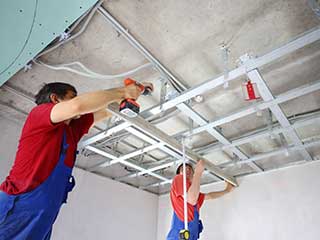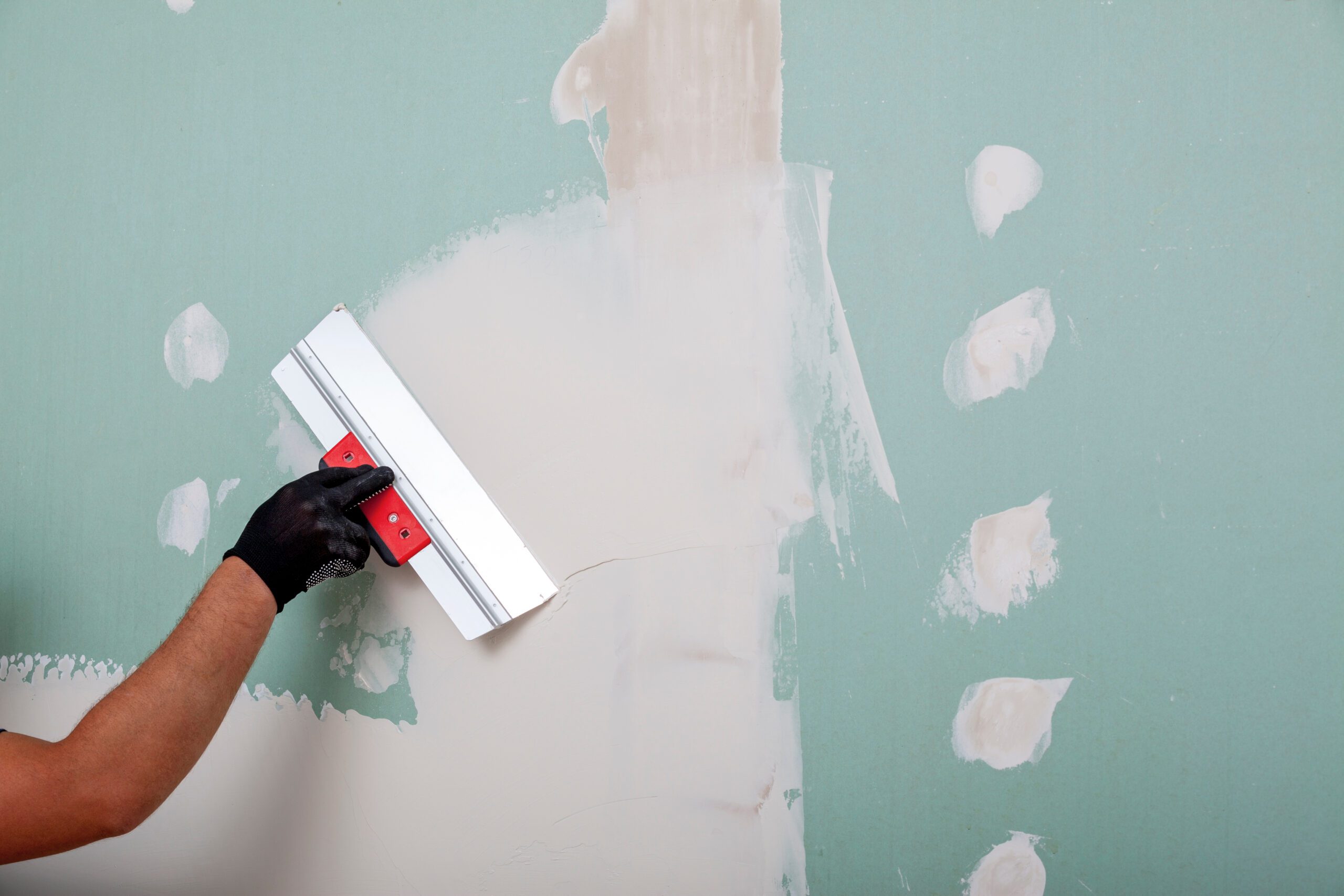Step-by-Step Approaches to Getting Flawless Drywall Repair and Installment
Achieving remarkable drywall repair work and setup calls for an organized approach. It entails recognizing the various types of drywall and the devices required for the job. Correct location preparation is essential before beginning any job. drywall contractor. Each action, from patching openings to setting up brand-new sheets, demands focus to detail. The procedure doesn't end with installation; finishing methods are critical for a refined appearance. The following actions will guarantee a seamless outcome, but what specifically do they entail?
Recognizing Drywall Kind and Equipment Needed

The installation tools are just as crucial. An utility blade is vital for cutting drywall sheets, while a drywall saw can aid in making precise cuts for fixtures or electrical outlets. T-squares guarantee exact measurements, and drywall screws or nails protect the panels to wall surface studs. Additionally, a drywall lift can facilitate the installation of huge sheets, reducing physical stress. Experience with these kinds and tools appreciably adds to the efficiency and top quality of drywall jobs.
Preparing the Location for Repair Service or Installation
Preparing the location for drywall repair work or setup is vital to guarantee a smooth and effective procedure. The surrounding space ought to be removed of furnishings and various other obstacles to offer adequate working space. This not just assures safety however additionally protects against damage to possessions. Next off, it is necessary to cover the flooring with ground cloth to catch any kind of debris or dirt created throughout the work.
In addition, the walls need to be inspected for any loose paint or wallpaper that may conflict with attachment. Eliminating these components develops a tidy surface for the brand-new drywall. Prior to beginning, it is a good idea to switch off power to electrical outlets or fixtures in the area. Making certain ample lights in the work space will even more improve exposure and focus during the repair work or setup process. Drywall Repair Ogden UT. By diligently preparing the location, one lays the foundation for an effective drywall task
Step-by-Step Process for Patching Holes

Patching holes in drywall requires a systematic method to guarantee a seamless repair service. The initial step involves evaluating the dimension of the opening. For tiny openings, a patching compound might suffice, while larger holes necessitate a spot. Next off, the damaged area needs to be cleansed and prepared by eliminating any type of loose particles.
For tiny holes, applying spackling substance with a putty blade is suggested, smoothing it over the hole and feathering the sides. When completely dry, fining sand the location assures a smooth surface. For larger holes, a drywall patch should be cut to dimension, placed over the opening, and safeguarded with screws. After installing the patch, the same spackling procedure is repeated, complied with by sanding.
The patched location has to be topped and painted to match the surrounding wall. This thorough procedure assures a specialist look and prolongs the life expectancy of the fixing.
Installing New Drywall Sheets: A Comprehensive Overview
Installing new drywall sheets needs careful preparation and implementation to assure a tough and aesthetically enticing coating. First, the area has to be determined precisely to determine the number of sheets needed. It is important to select the right density, usually 1/2-inch for indoor wall surfaces and 5/8-inch for ceilings or fire-rated applications.
Next off, the studs or framework need to be examined for any kind of irregularities, making sure they are straightened and correctly spaced. When placing the drywall sheets, they need to be positioned flat to minimize joints and improve architectural integrity. A drywall lift can be advantageous for overhanging installations.
Fastening the sheets with drywall screws at suitable periods makes specific a secure setup. It is necessary to countersink the screws somewhat below the surface area to plan for the completing procedure. Following these standards will cause a strong foundation, prepared for the following action in drywall completing.
Completing Touches: Taping, Mudding, and Fining Sand Techniques
When the drywall sheets are firmly attached, the emphasis shifts to the finishing touches that will give a sleek look. This process begins with taping, making use of either paper or fiberglass mesh tape to cover the seams between sheets. The tape ensures a smooth here change, minimizing the danger of cracking. Complying with insulation, mudding is vital; a joint substance is used over the tape to load gaps and produce a smooth surface area. Typically, numerous coats are essential, every one feathered out better than the previous to decrease exposure.
After adequate drying time, sanding is the last action in achieving a flawless coating. A fine-grit sandpaper is utilized to smooth the dried compound, guaranteeing there are no bumps or blemishes. Attention to detail throughout this phase is considerable, as it substantially affects the general appearance of the wall surface. The end result must be an even, professional-looking surface all set for priming and painting.
Often Asked Concerns
Exactly how Do I Choose the Right Drywall Density for My Task?
To select the right drywall density, take into consideration the job's objective, area, and architectural requirements. Standard densities include 1/2-inch for general usage and 5/8-inch for fire-rated applications, guaranteeing toughness and compliance with building ordinance.

Can I Install Drywall Over Existing Drywall?
Yes, setting up drywall over existing drywall is feasible. However, it is essential to guarantee the underlying surface area is free and safe from damage. Correct fastening and consideration of thickness are critical for a successful installment.
What Are the Finest Practices for Drywall Disposal?
The most effective techniques for drywall disposal include recycling when feasible, utilizing local waste monitoring solutions, and complying with standards for harmful materials if applicable. Drywall Installation Ogden Utah. Effectively securing and classifying waste guarantees compliance and security throughout disposal
How much time Should I Wait On Mud to Dry Prior To Fining sand?
Typically, one need to wait 24 hours for drywall mud to completely dry before fining sand. Nevertheless, drying out time can vary based on moisture and temperature level, so looking for a firm structure is recommended prior to proceeding.
Exist Eco-Friendly Drywall Options Available?
Yes, eco-friendly drywall alternatives are available. These alternatives typically make use of recycled materials, low-VOC adhesives, and lasting manufacturing approaches, decreasing ecological effect while providing efficient insulation and sturdiness for different building and renovation projects.
An utility blade is crucial for cutting drywall sheets, while a drywall saw can aid in making specific cuts for electrical outlets or fixtures. Preparing the location for drywall fixing or installation is crucial to assure a smooth and effective procedure. Covering openings in drywall requires a systematic method to guarantee a seamless repair work. Setting up new drywall sheets needs cautious preparation and implementation to assure a visually enticing and tough coating. Yes, installing drywall over existing drywall is possible.